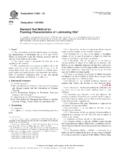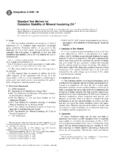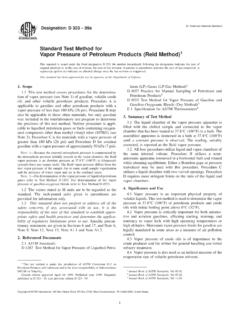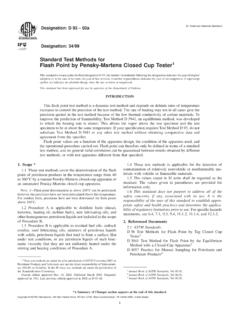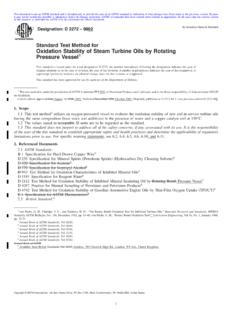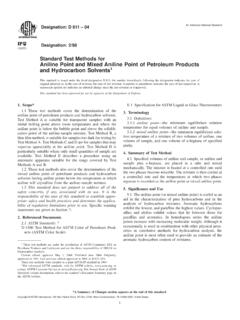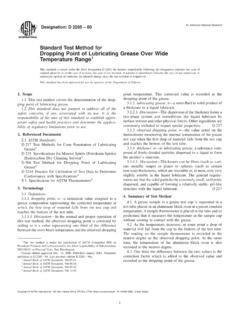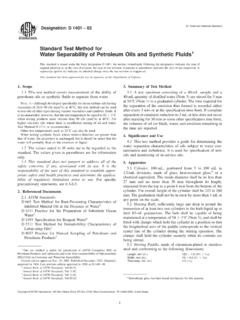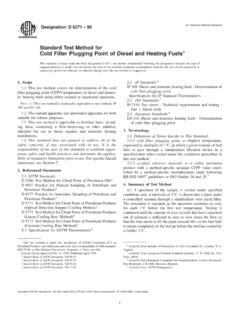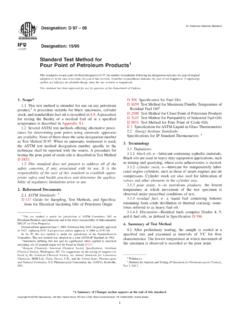Transcription of Standard Test Method for Rust-Preventing …
1 Designation: D 665 02 Designation: 135/93An American National StandardStandard Test Method forRust- preventing characteristics of inhibited mineral Oil inthe Presence of Water1 This Standard is issued under the fixed designation D 665; the number immediately following the designation indicates the year oforiginal adoption or, in the case of revision, the year of last revision. A number in parentheses indicates the year of last reapproval. Asuperscript epsilon (e) indicates an editorial change since the last revision or Standard has been approved for use by agencies of the Department of This test Method is used to evaluate the ability ofinhibited mineral oils, particularly steam-turbine oils, to aid inpreventing the rusting of ferrous parts should water becomemixed with the oil. This test Method is also used for testingother oils, such as hydraulic oils and circulating oils. Provisionis made in the procedure for testing heavier-than-water For synthetic fluids, such as phosphate ester types, the plasticholder and beaker cover should be made of a chemically resistant material,such as polytetrafluoroethylene (PTFE).
2 Standard does not purport to address all of thesafety concerns, if any, associated with its use. It is theresponsibility of the user of this Standard to establish appro-priate safety and health practices and determine the applica-bility of regulatory limitations prior to specificprecautionary statements, see Referenced Standards:A 108 Specification for Steel Bars, Carbon, Cold-Finished, Standard Quality2A 240/A 240M SpecificationforChromiumandChromium-Nick el Stainless Steel Plate, Sheet, and Stripfor Pressure Vessels and for General Applications3D 91 Test Method for Precipitation Number of LubricatingOils4D 1193 Specification for Reagent Water5D 2422 Classification of Industrial Fluid Lubricants byViscosity System4D 3603 Test Method for Rust-Preventing characteristics ofSteam Turbine Oil in the Presence of Water (HorizontalDisk Method )6D 4057 Practice for Manual Sampling of Petroleum andPetroleum Products6E 1 Specification for ASTM Thermometers7 Motor Fuels, Section I, Annex A2, Reference Materials andBlending Documents.
3 Specifications-IP Standard Thermometers, Appendix A9 Specifications for IP Standard Reference Liquids, Appen-dix B9 SAE Standard J 405 Chemical Composition of SAEW rought Stainless Steels10BS 871 Specification for abrasive papers and cloths9BS 970:Part 1: Carbon and Carbon Manganese SteelsIncluding Free Cutting Steels93. Summary of Test A mixture of 300 mL of the oil under test is stirred with30 mL of distilled water or synthetic sea water, as required, ata temperature of 6061 C (14062 F) with a cylindrical steeltest rod completely immersed therein. It is recommended to runthe test for 4 h; however, the test period may, at the discretionof the contracting parties, be for a shorter or longer period. Thetest rod is observed for signs of rusting and, if desired, degreeof Until 1999 it was customary to run the test for 24 h. A roundrobin with comparisons of different test times showed that no statistically1 This test Method is under the jurisdiction of ASTM Committee D02 onPetroleum Products and Lubricants and is the direct responsibility of on Corrosion and Water/Air edition approved Nov.
4 10, 2002. Published December 2002. Originallyapproved in 1942. Last previous edition approved in 1999 as D 665 the IP, this test Method is under the jurisdiction of the StandardizationCommittee. This test Method was adopted as a joint ASTM IP Standard in Book of ASTM Standards, Vol Book of ASTM Standards, Vol Book of ASTM Standards, Vol Book of ASTM Standards, Vol Book of ASTM Standards, Vol Book of ASTM Standards, Vol Book of ASTM Standards, Vol Book of IP Standard Methods for Analysis and Testing of Petroleum andRelated Products, Vol SAE Handbook, Vol ASTM International, 100 Barr Harbor Drive, PO Box C700, West Conshohocken, PA 19428-2959, United differences in rating were found for any sample, between the 4and 24 h Significance and In many instances, such as in the gears of a steamturbine, water can become mixed with the lubricant, andrusting of ferrous parts can occur. This test indicates how wellinhibited mineral oils aid in preventing this type of test Method is also used for testing hydraulic andcirculating oils, including heavier-than-water fluids.
5 It is usedfor specification of new oils and monitoring of in-service This test Method was used as a basis for Test Method D Method D 3603 is used to test the oil on separate horizontal andvertical test rod surfaces, and can provide a more discriminating Bath A thermostatically controlled liquid bathcapable of maintaining the test sample at a temperature of 6061 C (14062 F) (see Note 4). An oil having a viscosity ofapproximately ISO VG 32 (see Classification D 2422) issuitable for the bath. The bath shall have a cover with holes toaccommodate the test ASTM Thermometer 9C (9F), as prescribed in SpecificationE 1, or IP Thermometer 21C in accordance with IP Volume 2, AppendixA, is suitable to indicate the temperature. Alternatively, calibrated ther-mocouples may be A 400-mL, Berzelius-type, tall-form heat-resistant glass12beaker without pourout, as shown in Fig. 1,approximately 127 mm (5 in.)
6 In height measured from theinside bottom center and approximately 70 mm (23 4in.) ininside diameter measured at the Cover A flat beaker cover of glass or poly(methyl methacrylate) (PMMA) (Note 5), kept in position bysuitable means such as a rim or groove. Two holes shall beprovided on any diameter of the cover; one for a stirrer 12 mm(15 32in.) in diameter with its center mm (1 4in.) from thecenter of the cover; and the other, on the opposite side of the11 Supporting data (results of the cooperative test program with modified testduration) have been filed at ASTM International Headquarters and may be obtainedby requesting Research Report RR: glass is satisfactory for this All units are in millimetres, unless otherwise 1 Rusting Test ApparatusD665 022center of the cover, for the test rod assembly (see Section 8), 18mm (45 64in.) in diameter with its center 16 mm (5 8in.) fromthe center of the cover.
7 In addition, a third hole 12 mm (15 32in.) in diameter shall be provided for a temperature measuringdevice, with its center mm (7 8in.) from the center of thecover and on a diameter of the cover at right angles to thediameter through the other two An inverted petri dish makes a suitable cover, as the sides ofthe dish aid in keeping it in position. Fig. 2 shows a PMMA resin coverfor the beaker which has been found to be suitable. An optional feature isshown, consisting of a slot, by 27 mm (1 16by 11 16in.), which iscentered on a diameter of the stirrer hole at right angles to the coverdiameter through the test rod hole and stirrer hole. This feature allowswithdrawal of the stirrer while the beaker cover is in place. When the testmethod test is used for other fluids such as synthetics, the beaker covershould be made from chemically resistant material such as polymonochlo-rotrifluoroethylene (PCTFE).
8 The plastic holder shall be made of PMMA resin inaccordance with the dimensions shown in Fig. 3 (two types ofholders are illustrated). When testing synthetic fluids, theplastic holder should be made from chemically resistantmaterial such as polytetrafluoroethylene (PTFE). A stirrer constructed entirely from stainlesssteel (Note 6 and Note 7) in the form of an inverted T. A flatblade 25 by 6 by mm (1 by by in.) shall beattached to a 6-mm ( ) rod in such a way that the bladeis symmetrical with the rod and has its flat surface in thevertical A suitable material is an 18 % chromium, 8 % nickel alloysteel conforming to Type 304, of Specification A 240/A 204M, or SAENo. 30304 (see SAE J405), or BS 970: Part 1: 1983: If stainless steel is not obtainable, stirrers made of heat-resistant glass12and having approximately the same dimensions as thestainless steel stirrers specified can be Apparatus Any convenient form of stirringapparatus capable of maintaining a speed of 1000650 and Polishing Equipment A 150-grit9(99- m) and a 240-grit9(58- m) in accordance with BS 871 or itsequivalent, metalworking aluminum oxide abrasive cloth coaton a jeans backing, a suitable chuck (see Fig.)
9 4) for holding thetest rod, and a means of rotating the test rod at a speed of 1700to 1800 , capable of maintaining a temperature of 65 C(150 F).6. Reagents and of Reagents Reagent grade chemicals shall beused in all tests. Unless otherwise indicated, it is intended thatall reagents conform to the specifications of the Committee onAnalytical Reagents of the American Chemical Society whereNOTE All units are in millimetres, unless otherwise 2 Beaker CoverD665 023 NOTE All units are in millimetres, unless otherwise 3 Test Rod and HoldersNOTE All units are in millimetres, unless otherwise 4 Chuck for Polishing Test RodsD665 024such specifications are grades may be used,provided it is first ascertained that the reagent is of sufficientlyhigh purity to permit its use without lessening the accuracy ofthe of Water Unless otherwise indicated, referencesto water shall be understood to mean reagent water as definedby Type II of Specification D The synthetic sea water shall have the following com-position.
10 The solution can be conveniently prepared as procedure avoids any precipitation in concentrated solu-tions with subsequent uncertainty of complete certified pure (cp) chemicals and distilled water, preparethe following stock solutions:Stock Solution No. 1:MgCl2 6H2O3885 gCaCl2(anhydrous)406 gSrCl2 6H2O14gDissolve and dilute to 7 LStock Solution No. 2:KCl483 gNaHCO3140 gKBr70 gH3BO321 gDissolve and dilute to 7 To prepare the synthetic sea water, dissolve g ofNaCl and g of Na2SO4in a few litres of distilled water,add 200 mL of Stock Solution No. 1 and 100 mL of StockSolution No. 2 and dilute to 10 L. Stir the 10-L batch and until the pH is between and or two millilitres of the carbonate solution will Naphtha, as specified in Test MethodD 91. (Warning Flammable. Health hazard.) , as specified in Table 32, Motor Fuels SectionI, Annex A2, Reference Materials and Blending (Warning Flammable.)
